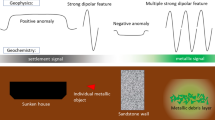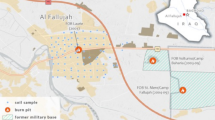Abstract
Ambient dose equivalent conversion coefficients (ADCRCs) for converting a radiocaesium inventory to ambient dose equivalent rates (air dose rates) depend on the vertical distribution of radiocaesium in soil. To access the validity of ADCRCs, the air dose rate at 1 m above ground and the vertical distribution of radiocaesium in the soil around the Fukushima Daiichi Nuclear Power Station (FDNPS) present between 2011 and 2019 were measured in the current study. ADCRCs were calculated using air dose rates and three different parameters representing the vertical distribution of radiocaesium in soil: (1) relaxation mass depth (β), (2) effective relaxation mass depth (βeff) and (3) relaxation mass depth recommended by the International Commission on Radiation Units and Measurements before the FDNPS accident (βICRU). When ADCRCs based on β and βeff were compared to those based on β and βICRU, a positive correlation was found. To confirm the applicability of the ADCRCs based on the three types of β values, radiocaesium inventories were estimated using the air dose rates and ADCRCs, and the obtained results were compared to the radiocaesium inventory calculated using soil sample measurements. Good agreement was observed between the radiocaesium inventories estimated using the ADCRCs based on β and βeff and measured by investigating soil samples. By contrast, the radiocaesium inventory estimated using the ADCRCs based on βICRU was overestimated compared with that measured by investigating soil samples. These findings support the applicability of ADCRCs based on β and βeff in the Fukushima region. Furthermore, the βICRU result suggests that differences in soil characteristics between Japan and other countries should be considered for evaluating ADCRCs.








Similar content being viewed by others
Availability of data and materials
The original dataset for the vertical distribution of radiocaesium in the soil obtained in this study was published on the website of the Japan Atomic Energy Agency (https://emdb.jaea.go.jp/emdb/contents/2/). The original dataset of the reconstructed fallout map in Fig. 1 is available online from the website of the Centre for Research in Isotopes and Environmental Dynamics, University of Tsukuba (www.ied.tsukuba.ac.jp/∼fukushimafallout/).
Change history
10 April 2022
A Correction to this paper has been published: https://doi.org/10.1007/s00411-022-00973-7
References
Andoh M, Mikami S, Tsuda S, Yoshida T, Matsuda N, Saito K (2019) Decreasing trend of ambient does equivalent rates over a wide area in eastern Japan until 2016 evaluated by car-borne surveys using KURAMA systems. J Environ Radioact 210:105813. https://doi.org/10.1016/j.jenvrad.2018.09.011
Beck HL (1966) Environmental gamma radiation from deposited fission products, 1960–1964. Health Phys 12:313–322. https://doi.org/10.1097/00004032-196603000-00002
Beck HL, Krey PW (1980) Cesium-137 inventories in undisturbed Utah soils: Interim report on radionuclides in soils of populated areas, Report No. EML-375 (U.S. Department of Energy, Environmental Measurements Laboratory, New York). https://doi.org/10.2172/5374889
Chino M, Terada H, Nagai H, Katara G, Mikami S, Torii T, Saito K, Nishizawa Y (2016) Utilization of 134Cs/137Cs in the environment to identify the reactor units that caused atmospheric releases during the Fukushima Daiichi accident. Sci Rep 6:31376_1-31376_14. https://doi.org/10.1038/srep31376
Faller S (1992) In-situ gamma-ray site characterization of the Tatum Salt Dome Test Site in Lamar Country, Mississippi. Health Phys 62(6):571–575. https://doi.org/10.1097/00004032-199206000-00012
Golikov VY, Balonov MI, Ponomarev AV (1993) Estimation of external gamma radiation doses to the population atter the Chernobyl accident. In: Merwin SE, Balonov MI (eds) The Chernobyl papers 247–288. Vo. 1 doses in the soviet population and early health effect studies. Research Enterprises Publishing Segment, Richland
ICRU (1994) Report 53. Gamma-ray spectrometry in the environment. International commission on radiation units and measurements. Maryland. https://catalog.library.vanderbilt.edu/discovery/fulldisplay/alma991026952719703276/01VAN_INST:vanui
Jacob P, Meckbach R, Paretzke HG, Likhtariov I, Los I, Kovgan L, Komarikov I (1994) Attenuation effects on the kerma rates in air after cesium depositions on grasslands. Radiat Environ Biophys 33:251–267. https://doi.org/10.1007/bf01212681
Jacob P, Meckbach R (1992) Recent developments in in situ γ spectrometry. In: Proceedings of the International Radiation Protection Association, vol 8. International Radiation Protection Association, Montréal, Quebec, Canada, pp 305–308
JAEA (2020) Investigations on distribution of radioactive substances owing to the Fukushima Dai-ichi Nuclear Power Station Accident in the fiscal year 2019 (Contact Research). JAEA Technol. https://doi.org/10.11484/jaea-technology-2020-014
Kato H, Onda Y, Gao X, Sanada Y, Saito K (2019) Reconstruction of a Fukushima accident-derived radiocesium fallout map for environmental transfer studies. J Environ Radioact 210:105996. https://doi.org/10.1016/j.jenvrad.2019.105996
Kerlberg O (1987) Weathering and migration of Chernobyl fallout in Sweden. Radiat Prot Dosim 21(1–3):75–78. https://doi.org/10.1093/oxfordjournals.rpd.a080056
Khomutinin Yu, Fesenko S, Levchuk S, Zhebrovska K, Kashparov V (2020) Optimising sampling strategies for emergency response: soil sampling. J Environ Radioact 222:106344. https://doi.org/10.1016/j.jenvrad.2020.106344
Kinoshita N, Sueki K, Sasa K, Kitagawa J, Ikarashi S, Nishimura T, Wong Y, Satou Y, Handa K, Takahashi T, Sato M, Yamagata T (2011) Assessment of individual radionuclide distributions from the Fukushima nuclear accident covering central-east Japan. Proc Nat Acad Sci USA 108(49):19526–19529. https://doi.org/10.1073/pnas.1111724108
Kurikami H, Malins A, Takeishi M, Saito K, Iijima K (2017) Coupling the advection-dispersion equation with fully kinetic reversible/irreversible sorption terms to model radiocesium soil profiles in Fukushima Prefecture. J Environ Radioact 171:99–109. https://doi.org/10.1016/j.jenvrad.2017.01.026
Maekawa A, Momoshima N, Sugihara S, Ohzawa R, Nakama A (2015) Analysis of 134Cs and 137Cs distribution in soil of Fukushima prefecture and their specific adsorption on clay minerals. J Radioanal Nucl Chem 303:1485–1489. https://doi.org/10.1007/s10967-014-3575-2
Malins A, Okumura M, Machida M, Takemiya H, Saito K (2015) Fields of view for environmental radioactivity. In: Proceedings of the 2015 international symposium on radiological issues for Fukushima’s revitalized Fukushima. Japan, pp 1–6
Matsuda N, Mikami S, Shimoura S, Takahashi J, Nakano M, Shimada K, Uno K, Hagiwara S, Saito K (2015) Depth profiles of radioactive cesium in soil using a scraper plate over a wide area surrounding the Fukushima Dai-ichi Nuclear Power Plant, Japan. J Environ Radioact 139:427–434. https://doi.org/10.1016/j.jenvrad.2014.10.001
Mikami S, Maeyama T, Hoshide Y, Sakamoto R, Sato S, Okuda N, Demongeot S, Gurriaran R, Uwamino Y, Kato H, Fujiwara M, Sato T, Takemiya H, Saito K (2015) Spatial distributions of radionuclides deposited onto ground soil around the Fukushima Dai-ichi Nuclear Power Plant and their temporal change until December 2012. J Environ Radioact 139:320–343. https://doi.org/10.1016/j.jenvrad.2014.09.010
Mikami S, Tanaka H, Matsuda H, Sato S, Hoshide Y, Okuda N, Suzuki T, Sakamoto R, Andoh M, Saito K (2019) The deposition densities of radiocesium and the air dose rates in undisturbed fields around the Fukushima Dai-ichi nuclear power plant; their temporal changes for five years after the accident. J Environ Radioact 210:105941. https://doi.org/10.1016/j.jenvrad.2019.03.017
Miller KM, Kuiper JL, Helfer IK (1990) 137Cs fallout depth distributions in forest versus field sites: Implications for external gamma dose rates. J Environ Radioact 12(1):23–47. https://doi.org/10.1016/0265-931X(90)90034-S
Nagaoka K, Honda K, Miyano K (1996) Cosmic-ray contribution in measurement of environmental gamma-ray dose. Radioisotopes 45:665–674. https://doi.org/10.3769/radioisotopes.45.11_665(inJapanese)
NRA (Nuclear Regulation Authority, Japan) (2017) In-situ measurement using germanium detector. Ser Environ Radioact Meas Methods 33:1–100
Ochi K, Sasaki M, Ishida M, Hamamoto S, Nishimura T, Sanada Y (2017) Estimation of the vertical distribution of radiocesium in soil on the basis of the characteristics of gamma-ray spectra obtained via aerial radiation monitoring using an unmanned helicopter. Int J Environ Res Public Health 14(8):926_1-926_14. https://doi.org/10.3390/ijerph14080926
Onda Y, Kato H, Hoshi M, Takahashi Y, Nguyen ML (2015) Soil sampling and analytical strategies for mapping fallout in nuclear emergencies based on the Fukushima Dai-ichi Nuclear Power Plant accident. J Environ Radioact 139:300–307. https://doi.org/10.1016/j.jenvrad.2014.06.002
Saito K, Jacob P (1995) Gamma ray fields in the air due to the sources in the ground. Radiat Prot Dosim 58(1):29–45. https://doi.org/10.1093/oxfordjournals.rpd.a082594
Saito K, Petoussi-Henss N (2014) Ambient dose equivalent conversion coefficients for radionuclides exponentially distributed in the ground. J Nucl Sci Technol 51(10):1274–1287. https://doi.org/10.1080/00223131.2014.919885
Saito K, Tanihata I, Fujiwara M, Saito T, Shimoura S, Otsuka T, Onda Y, Hoshi M, Ikeuchi Y, Takahashi F, Kinouchi N, Saegusa J, Seki A, Takemiya H, Shibata T (2015) Detailed deposition density maps constructed by large-scale soil sapling for gamma-ray emitting radioactive nuclides from the Fukushima Dai-ichi Nuclear Power Plant accident. J Environ Radioact 139:308–319. https://doi.org/10.1016/j.jenvrad.2014.02.014
Sanada Y, Urabe Y, Sasaki M, Ochi K, Torii T (2018) Evaluation of ecological half-life of dose rate based on airborne radiation monitoring following the Fukushima Dai-ichi nuclear power plant accident. J Environ Radioact 192:417–425. https://doi.org/10.1016/j.jenvrad.2018.07.016
Sanada Y, Yoshimura K, Urabe Y, Iwai K, Katengeza EW (2020) Distribution map of natural gamma-ray dose rates for studies of additional exposure dose after the Fukushima Dai-chi Nuclear Power Station accident. J Environ Radioact 223–224:106397. https://doi.org/10.1016/j.jenvrad.2020.106397
Takahashi J, Tamura K, Suda T, Matsumura R, Onda Y (2015) Vertical distribution of and temporal changes of 137Cs in soil profiles under various land uses after the Fukushima Dai-ichi Nuclear Power Plant accident. J Environ Radioact 139:351–361. https://doi.org/10.1016/j.jenvrad.2014.07.004
Takahashi Y, Fan Q, Suga H, Tanaka K, Sakaguchi A, Takeichi Y, Ono K, Mase K, Kato K, Kanivets VV (2017) Comparison of solid-water partitions of radiocesium in river waters in Fukushima and Chernobyl areas. Sci Rep 7:12407_1-12407_11. https://doi.org/10.1038/s41598-017-12391-7
UNSCEAR (2021) Levels and effects of radiation exposure due to the accident at the Fukushima Daiichi Nuclear Power Station: implications of information published since the UNSCEAR 2013 Report. UNSCEAR 2020 report, SCIENTIFIC ANNEX B
Yoshimura K, Saegusa J, Sanada Y (2020) Initial decrease in the ambient dose equivalent rate after the Fukushima accident and its difference from Chernobyl. Sci Rep 10:3859_1-3859_9. https://doi.org/10.1038/s41598-020-60847-0
Funding
This study was conducted as a part of the national mapping projects funded by the Ministry of Education, Culture, Sports, Science and Technology and the Nuclear Regulation Authority, Japan.
Author information
Authors and Affiliations
Contributions
KO: conceptualisation, methodology, investigation, writing and editing of original draft and visualisation; HF: methodology and review of original draft; KY: methodology and review of original draft; TI: methodology and review of original draft; NM: methodology and investigation, review of original draft and project administration; YS: methodology, review of original draft and project administration.
Corresponding author
Ethics declarations
Conflict of interest
The authors declare that they have no conflict of interest.
Additional information
Publisher's Note
Springer Nature remains neutral with regard to jurisdictional claims in published maps and institutional affiliations.
The original online version of this article was revised: Corrections to equations 5,13 and few text corrections updated
Electronic supplementary material
Below is the link to the electronic supplementary material.
411_2022_969_MOESM1_ESM.pdf
Supplementary file1 Fig. S1 Relative and cumulative frequency distributions of the coefficient of variation (CV) obtained for the radiocaesium inventory in the soil (PDF 11 KB)
Appendix
Appendix
The radiocaesium inventory in the soil at each campaign was decay-corrected on the same day (15 March 2011). The coefficient of variation (CV) of the decay-corrected radiocaesium inventory in the soil (MI0 (Bq m−2)) at the study sites was obtained using Eq. 12:
where σ is the standard deviation of MI0 and \(\overline{{\mathrm{MI} }_{0}}\) is the mean of MI0. The CV was evaluated based on MI0 obtained at the same site over several different campaigns. The CV was not evaluated based on MI0 at the site where the campaign was performed once or twice.
To obtain βeff, the air kerma rate and inventory of 137Cs were obtained with Eqs. 13 and 14, respectively.
where Iγ is the gamma-ray emission rate per 137Cs activity (photons Bq−1), C(ζ) is the conversion coefficient of the source intensity of 137Cs in soil (photons m−2) to the air kerma (Gy) (Saito and Jacob 1995) and Am,ζ0′ is the activity concentration of 137Cs at ζ0 (Bq kg−1). In the case of type A profile, ζ0 is infinitely close to zero because the mass depth where the activity concentration of 137Cs is the highest is located in top soil layer. The calculation method for βeff is the same in either of case type A and B profile.
Rights and permissions
About this article
Cite this article
Ochi, K., Funaki, H., Yoshimura, K. et al. Validation study of ambient dose equivalent conversion coefficients for radiocaesium distributed in the ground: lessons from the Fukushima Daiichi Nuclear Power Station accident. Radiat Environ Biophys 61, 147–159 (2022). https://doi.org/10.1007/s00411-022-00969-3
Received:
Accepted:
Published:
Issue Date:
DOI: https://doi.org/10.1007/s00411-022-00969-3




